

HELPING YOU DELIVER ON DEMAND

Whether it’s improving soybean meal to outperform the competition or promoting the sustainability of U.S. soy, the soy checkoff has been working behind the scenes to help farmers satisfy their customers’ needs. We’re looking inside the bean, beyond the bushel and around the world to keep preference for U.S. soy strong. And for U.S. soybean farmers like you, the impact is invaluable.
See more ways the soy checkoff is maximizing profit opportunities for farmers at unitedsoybean.org

COVER STORY: Stink bugs, soybean cyst nematodes, soybean gall midge, weeds — each fear Ohio State researchers and the soybean checkoff’s investment to tackle them. Dr. Kelley Tilmon, Professor of Entomology at The Ohio State University, is working to adapt stink bug scouting techniques using sticky pads and pheromones. Her research will help growers efficiently apply insecticides on their fields. The soybean checkoff invests in a variety of research projects so farmers can protect their fields from yield robbing pests. Read more on pages 14 – 26.
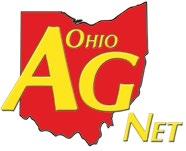


Patrick Knouff
Ohio Soybean Association President Shelby County soybean farmer
A Letter From the President
Happy New Year to all! As we enter into 2023, it provides an opportunity to reflect on all of the great things the Ohio Soybean Association (OSA) accomplished in the past 12 months. There is always something that can be done and that makes this organization rewarding to lead as well as beneficial for Ohio farmers. A new year means new ways to make those positive changes for our members. Our year in review can be found on page 5.
If you’ll remember, at the beginning of December, we were facing the prospect of a rail strike. I don’t have to tell you how harmful that would have been for our industry, especially given that other methods of transportation like trucking and barge were negatively impacted last year. Fortunately, thanks to our membership’s mobilization, Congress passed legislation that averted the strike. Without your input, this situation could have been much worse. It’s occasions like these that remind me of the real world impact our work has on important local and national issues, quite literally ensuring that our beans can keep moving.
Our members have been a big reason we have been able to make that positive impact, and coming off of an election, there is no better time to join to ensure your voice is heard and help us continue our policy work on behalf of the Buckeye State. If you are already a member, consider reaching out to your OSA district representative to see what we are doing and how you can help. More information on all of our memberships can be found by visiting soyohio.org/Membership.
I also want to highlight another annual OSA event coming up — the 2023 Commodity Classic! This event is an opportunity for our organization to shape the national policy agenda through the American Soybean Association (ASA) and will take place in Orlando March 9–11 at the Orange County Convention Center. A lot of great discussion and ideas will come from this event, and it is a great chance to see all that is happening in our industry.
Finally, I would like to share a few updates to our OSA board. First, I would like to thank Jerry Bambauer of Auglaize County for his 14 years of service as he finished his final term for both OSA and ASA at the end of last year. I also want to recognize our newly elected executive committee, voted on at our December board meeting. New to the committee are Bennett Musselman of Pickaway County, who was elected treasurer, and Jeff McKanna of Hancock County, who was elected secretary. Rusty Goebel of Williams County continues as vice president. You can read more about those farmer leaders on page 10.
Thank you for reading Ohio Soybean News and I look forward to another successful year for the OSA!
President
Patrick Knouff, Shelby County
Vice President
Rusty Goebel, Williams County
Treasurer
Bennett Musselman, Pickaway County
Secretary
Jeff McKanna, Hancock County
Chairman
Ryan Rhoades, Marion County
Trustees
David Clark, Warren County
Justin Esselburn, Holmes County
Austin Heil, Hardin County
Caitlyn Heimerl, Industry Affiliate Ex-Officio
Jeff Magyar, Ashtabula County
Jeff McKanna, Hancock County
Bennett Musselman, Pickaway County
Derek Reusser, Holmes County
Andy Stickel, Wood County
Bob Suver, Clark County
Kerrick Wilson, Preble County
American Soybean Association
Board Representatives
Rusty Goebel
Scott Metzger
Ryan Rhoades
Staff Credits
Kirk Merritt - Publisher
Julia Brown - Editor
Madi Layman - Staff Writer
Brent Warren - Art Director
Barry Falkner - Photo Quality/Proofer
Ohio Soybean news is published six times a year by the Ohio Soybean Association, 918 Proprietors Rd., Suite A, Worthington, OH 43085. Phone: 614-476-3100. For address corrections contact Ohio Soybean News at 918 Proprietors Rd., Suite A, Worthington, OH 43085.
Web address: www.soyohio.org
E-mail: cdeboard@soyohio.org
Comments and statewide news articles should be sent to the above address. Advertising space reservation must be made by the first of the month preceding publication. In consideration of the acceptance of advertisement, the agency and the advertiser must, in respect of the contents of the advertisement, indemnify and save the publisher harmless against any expense arising from claims or actions against the publisher because of the publication of the content of the advertisement.
For Advertising Sales Contact: Matt Herman - (612) 812-5833
matt.herman@dtn.com
Patrick Knouff
A Year in Review and What’s Coming in 2023

What an incredible year for the Ohio Soybean Association (OSA)! With the support of our members and corporate sponsors, OSA advocated on issues important to Ohio’s soybean farmers. Here is what we worked on:
AG-LINK: The agricultural linked (Ag-Link) deposit bill removed the statutory program loan cap and overall cap, leaving it to the Treasurer of State to decide. It also made agricultural cooperatives eligible to borrow under Ag-Link. This will help farmers finance upfront operating costs for feed, seed, fertilizer, fuel and other expenses.
BEGINNING FARMER TAX CREDIT: Starting in 2023, this legislation allows for an income tax credit for beginning farmers who attend a financial management program and a credit for individuals or businesses that sell or rent farmland, livestock, buildings or equipment to certified beginning farmers.
DOUBLE CROPPING: Double crop insurance opportunities expanded
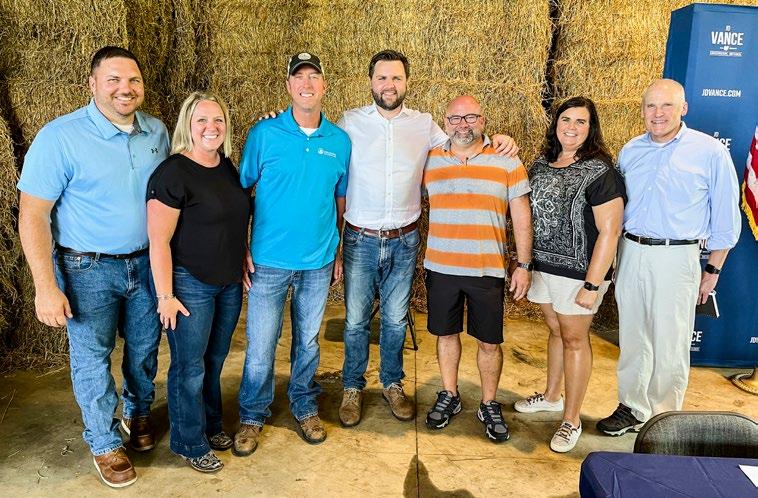
for soybeans in at least 681 counties nationwide, covering almost all Ohio counties. This will allow farmers in the Buckeye State to reduce the economic risk associated with growing two crops on the same land in the same year.
PROTECTION OF FARMER
TOOLS: OSA successfully urged U.S. Environmental Protection Agency (EPA) to review and approve the use of Enlist One and Enlist Duo in 134 additional counties, including several counties in Ohio.
With all the success of last year, your membership and support are even more vital in the upcoming year. As Congress debates the next Farm Bill, it’s critical for soybean farmers to have a strong voice in the process. In partnership with the American Soybean Association, our priorities are improving the Title 1 farm safety net for soybeans and continuing a voluntary, incentive-based flexible approach
to conservation programs. Ohio’s General Assembly will be faced with determining state budget allocations. We will advocate to maintain and expand funding for H2Ohio. u
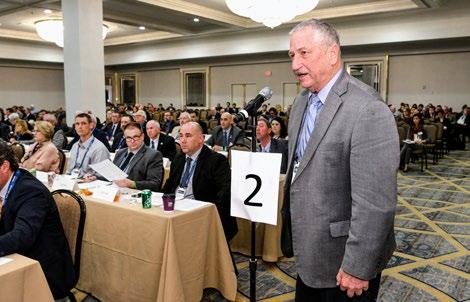
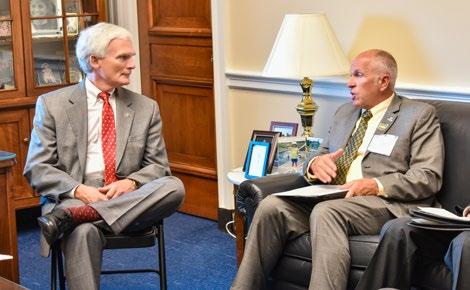
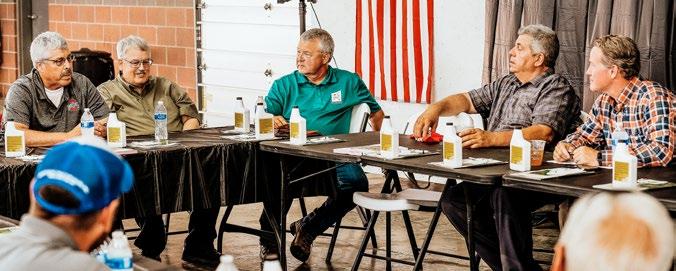
Soybean & Corn/Wheat Groups Host 2022 Ohio Grain Farmers Symposium
In November, the Ohio Soybean Association (OSA) and Ohio Corn & Wheat Growers Association (OCWGA) hosted the 2022 Ohio Grain Farmers Symposium at the Nationwide and Ohio Farm Bureau 4-H Center in Columbus. Grain farmers from across the state heard about topics critical to the future of the soybean industry. Both organizations conducted their annual meetings, and a Leadership Panel provided updates from both associations’ presidents and executive directors.
Featured topics included an update from The Ohio State University’s Farm Financial Management and
Policy Institute with Bruce Clevenger and John Foltz; Sustainable Aviation Fuel & the Potential for Agriculture with Paul Bertels from Farmgate Insights; an election recap with the American Soybean Association and National Corn Growers Association; and a grain marketing panel with representatives from Cargill, Consolidated Grain & Barge and The Andersons.
“With so much happening in the grain markets today, it was hard to narrow down topics for this year’s Grain Farmers Symposium,” said OSA President Patrick Knouff of Shelby County. “Our industries saw
several opportunities and drawbacks this year and I think we were able to address most of these during the programming. The future of sustainable aviation fuel looks bright for both industries thanks to the informative insights from Paul. Additionally, the grain markets panel talked about the transportation issues of this past year and how they are working with farmers to keep their grain moving. All-in-all another great year for the event.”
More information on speakers and presentations from the event can be found at ohiograinfarmerssymposium.org u

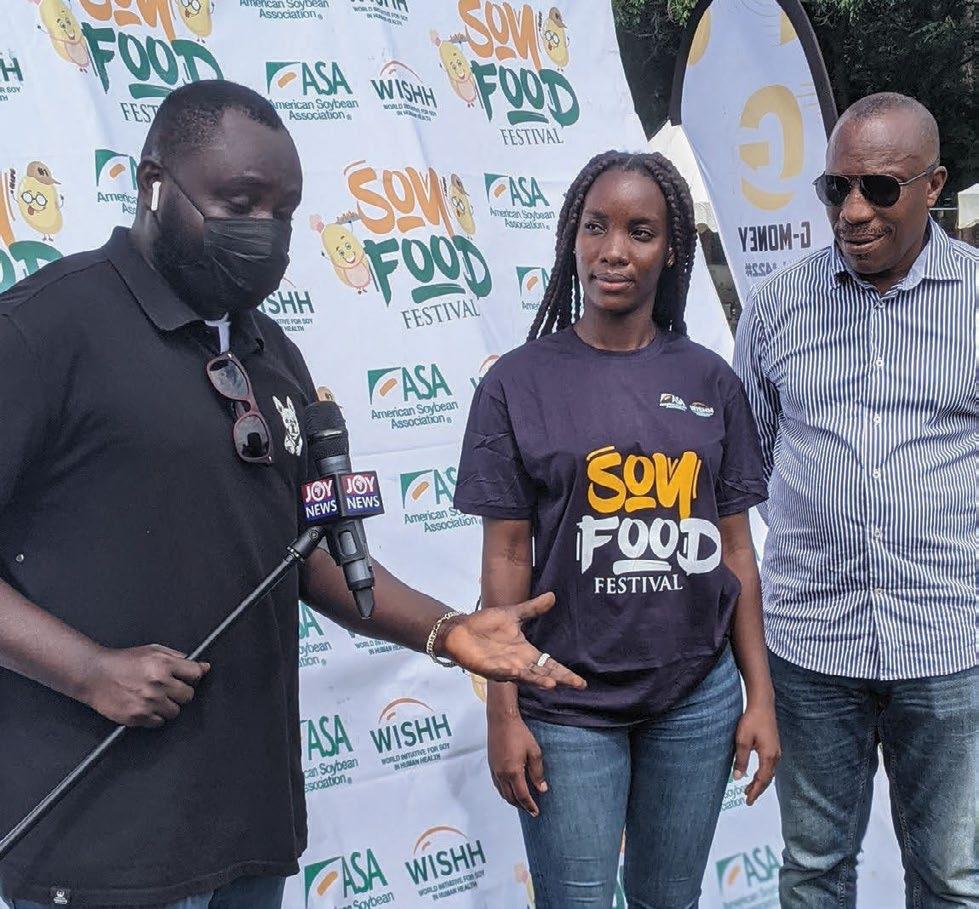
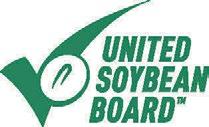


OHIO IS HOME TO CUTTING EDGE RESEARCH

The Ohio Soybean Council wants growers to stay on top of the most recent agronomic discoveries. That’s why your soybean checko developed Field Leader, an online resource to give you access to the latest soybean research.
Find all the ways the Ohio Soybean Council and soybean checko work for you by clicking the “Ohio Field Leader” tab at OCJ.com.
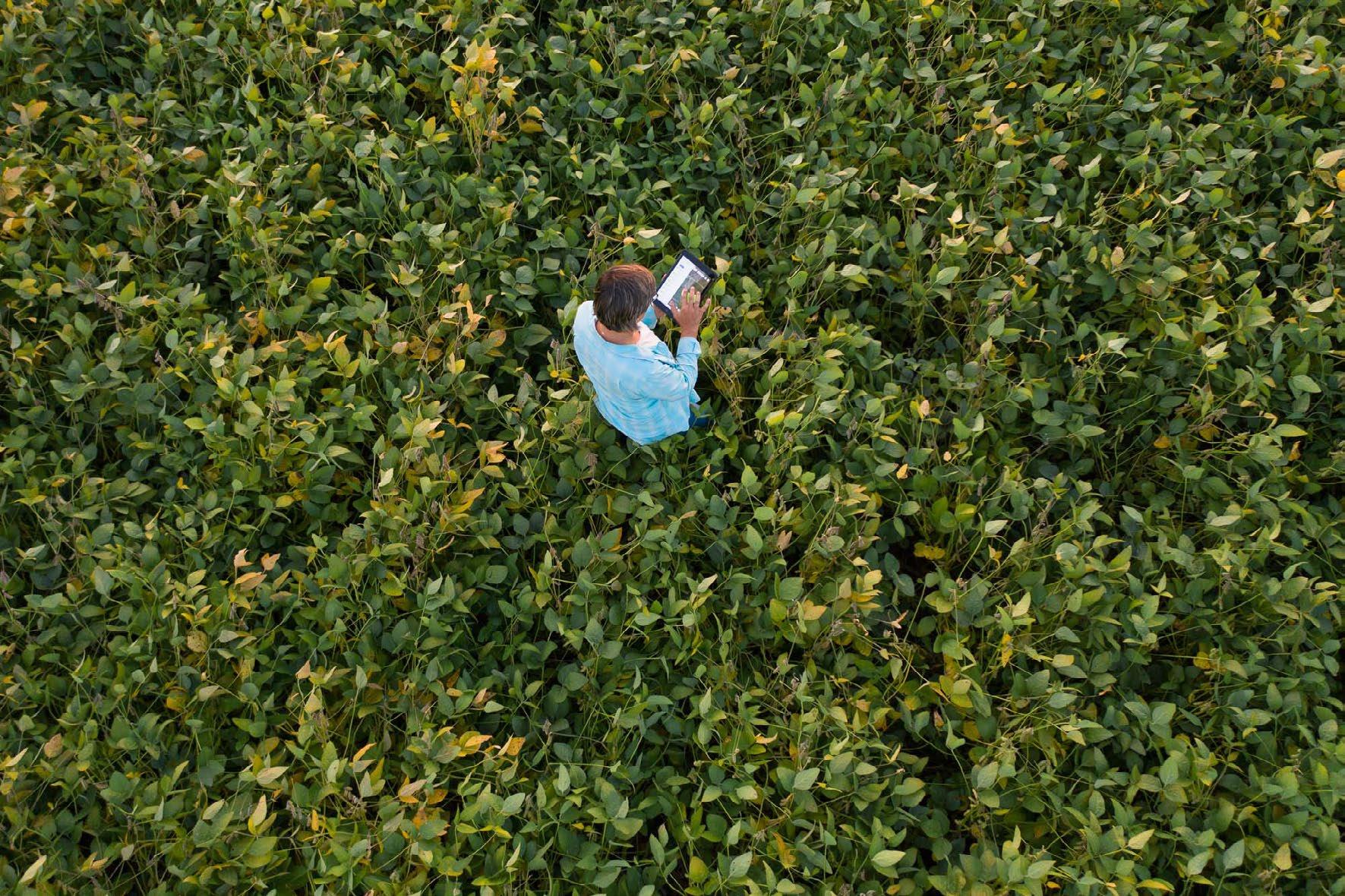


At CGB, our team is well equipped with expertise and professionally managed pricing tools to diversify your risk, because we understand your hard work hinges on how you market your grain.
•Knowledgeable, Dedicated Merchants
• Premium GrainsSM Opportunities for Non-GMO Corn and Non-GMO Soybeans
•Mobile App & Web Based Account Access
• Managed & Formula Priced Market Solutions Pricing Tools with Weekly Updates
• Accurate and Efficient Grain Settlements & Offer System
•Farm Pick-Up Trucking Service
• Corn, Soybean, and Wheat Terminal Bids

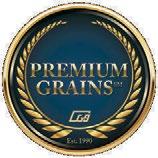
Ohio Soybean Association Celebrates Leadership Positions on State and National Levels
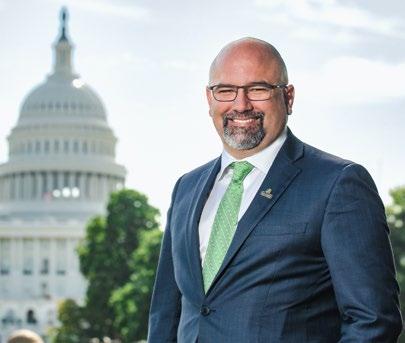

The Ohio Soybean Association (OSA) is excited to announce several new leadership roles for OSA board members. First, Scott Metzger, OSA board member from Ross County, was elected to serve as the American Soybean Association (ASA) treasurer for the upcoming year. He previously served as on ASA’s executive committee and as president of OSA. Metzger is also on the Ohio Soybean Council Board of Trustees .
“Scott has been a longtime leader for soybean organizations in Ohio

and nationally,” said OSA President Patrick Knouff, who farms in Shelby County. “His dedication to our industry and vast leadership experience make him an excellent choice for ASA’s treasurer.”
Metzger farms more than 3,100 acres of soybeans, corn and wheat. He received a B.S. in Agronomy and Agricultural Business at The Ohio State University. He has also participated in many leadership programs including Ohio Farm Bureau’s AgriPower and American Soybean Association’s Dupont Young Leader Program.
Additionally, during the November board meeting of OSA, board members elected Bennett Musselman of Pickaway County as treasurer and Jeff McKanna of Hancock County as secretary.
Musselman farms 550 acres of corn, soybeans, wheat and rye in Pickaway, Madison and Franklin Counties with his parents, wife and two sons. He also works off the farm for Leist Mercantile to provide risk management services for area farmers by utilizing grain marketing, hedging, futures trading, crop insurance, and property and casualty insurance. He and his wife Liza were past chairs of the Ohio Farm Bureau Young Ag Professionals and they completed the American Soybean Association Corteva Agriscience Young Leader Program in 2021.
McKanna farms over 500 acres of soybeans, corn and wheat. He is currently serving as the membership chair for OSA and represents District 5 including Allen, Hancock and Putnam Counties. u
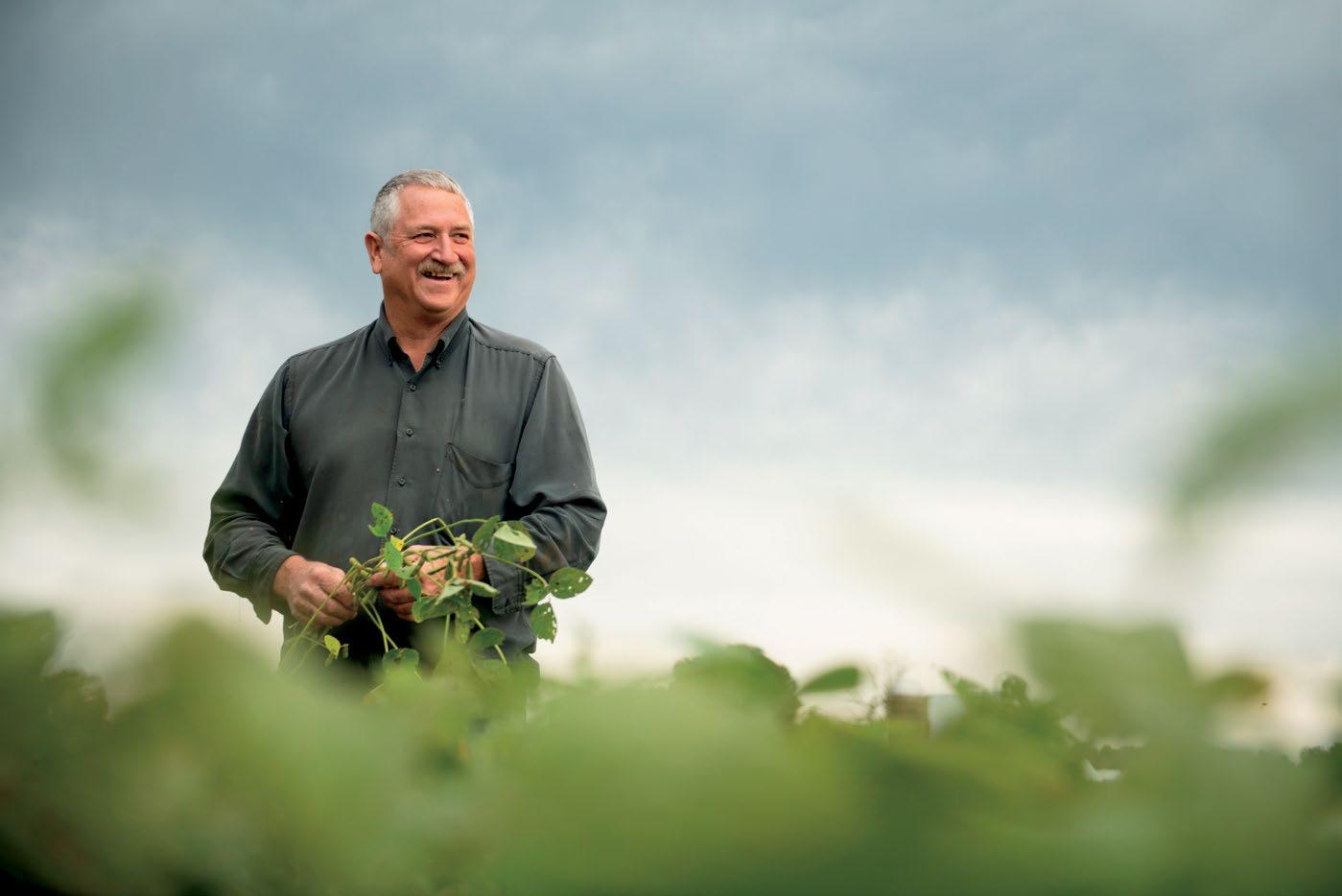
Jerry Bambauer for your many years of leadership on the Ohio Soybean Association Board of Trustees.

Scott Metzger
Bennett Musselman
Jeff McKanna

Full-Circle Return


HERE’S HOW THE SOY CHECKOFF WORKS. The national soy checkoff was created as part of the 1990 Farm Bill. The Act & Order that created the soy checkoff requires that all soybean farmers pay into the soy checkoff at the first point of purchase. These funds are then used for promotion, research and education at both the state and national level.
FARMERSSELLBEANS TO ELEVATORS, PROCESSORS&DEALERS

Half goes to the state checkoff for investment in areas that are a priority for that state.


1/2 of 1% of the total selling price collected per the national soybean act & order
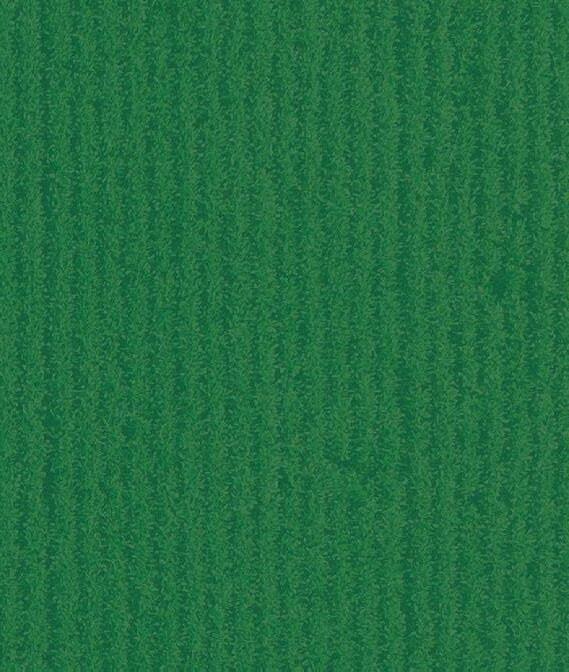
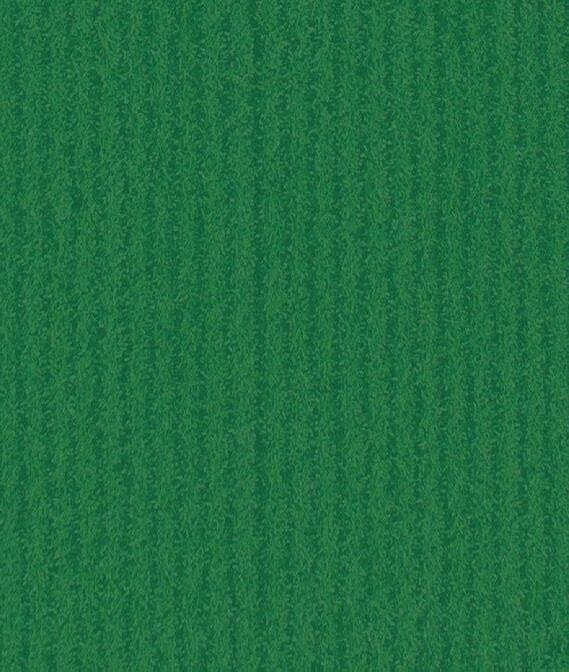
ROI TO THE FARMER
Half goes to the national checkoff for investment in USB’s long-range strategic plan.

Reinhard Elected as Vice Chairman for United Soybean Board
Ohio Soybean Council (OSC) board member Steve Reinhard was elected to lead the national United Soybean Board (USB) as its vice chair. Reinhard has served on USB since 2017 and previously served as the Demand Action Team Chair and treasurer.
“Congratulations to Steve on his newly elected position,” said Jeff Magyar, OSC chairman and Ashtabula County soybean farmer. “Steve is a sound leader with years of experience on checkoff boards who will represent the best interests of Ohio soybean farmers and farmers from across the country in his new role.”
Reinhard farms 1,300 acres of soybeans, corn and wheat in

Bucyrus. In addition to his position on USB, he serves on the OSC Board of Trustees, where he has previously served as Chairman,
Vice Chairman and Treasurer. In addition to his roles on OSC and USB, Reinhard also represented Ohio on the Soy Transportation Coalition Board of Trustees. He earned Bachelor of Science degrees from The Ohio State University in agriculture education and agriculture economics.
Other farmer leaders from around the country elected to the Executive Committee include Meagan Kaiser, Chair, Missouri; Ed Lammers, Secretary, Nebraska; Phillip Good, Treasurer, Mississippi; Gary Berg, Illinois; Belinda Burrier, Maryland; Matt Gast, North Dakota; Brent Gatton, Kentucky; April Hemmes, Iowa; and Laurie Isley, Michigan. u
Ohio Soybean Council Welcomes Eric Robinson as Communications Coordinator
The Ohio Soybean Council (OSC) is excited to welcome Eric Robinson to the staff as Communications Coordinator. In this role he will be responsible for content creation, editorial writing and editing, event management, digital marketing and social media outreach to both farmers and consumers.
“We are very happy to welcome Eric to the Ohio Soybean team,” said Jeff Magyar, OSC chairman and Ashtabula County soybean farmer. “His experience in the communication field makes him a great fit for the role and will enhance Ohio Soybean’s connections with farmers and consumers.”
Eric is a 2018 graduate of Butler University with a Bachelor of Arts in sports media. He comes to Ohio Soybean with several years of experience in the communications field. Following college, he worked as a graduate assistant in athletic communications at St. John’s University in New York. He then joined the Cincinnati Reds as a promotional events intern and later joined the University of Dayton as the athletic communications assistant. In this role, he managed the baseball, men’s tennis and women’s tennis promotional channels.
Eric grew up on a grain farm in Morris, IL. u
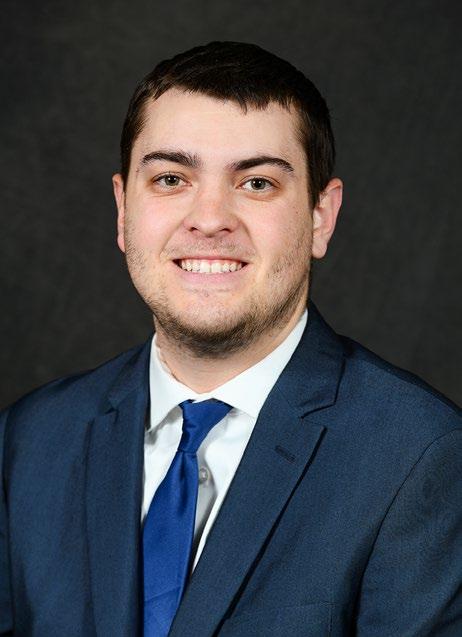
2023 Checkoff Board Leadership Update
The Ohio Soybean Council (OSC) is excited to share leadership role updates for the 2023 OSC Board of Trustees.
Industry Affiliates
OSC appreciates the partnerships shared with national groups that work to ensure market access for Ohio soybeans. One way the checkoff works with these groups is by sending representatives to serve on the various boards. This year OSC appointed several new faces to the partnering groups.
Upon completing his third term with the North Central Research Program (NCSRP), David Clark of Warren County was elected by the NCSRP board to serve on their executive committee. NCSRP is a soybean checkoff-funded program that leads in multi-state collaborative
Clark will also be serving on the Soy Transportation Coalition (STC) board with Nathan Eckel of Wood County. Clark will be entering his second term and Eckel his first term. STC’s goal is to position soybean industry stakeholders to benefit from a transportation system that delivers cost-effective, reliable and competitive service.
Cindy Layman of Hardin County was appointed to her second term as Ohio’s Clean Fuels Alliance America representative. Clean Fuels supports sustainable biodiesel, renewable diesel and sustainable aviation fuel industry growth.
New Board Member
In addition to the newly elected industry affiliates, David Black of Franklin County will be rejoining the board of trustees as District
as a district representative but will remain on the board due to his seat on the United Soybean Board of Directors.
Black farms soybeans, corn, wheat and hay in Orient. He previously served on the board of trustees from 2005 to 2013. He will be representing Belmont, Carroll, Coshocton, Fairfield, Franklin, Guernsey, Harrison, Holmes, Jefferson, Knox, Licking, Monroe, Morgan, Muskingum, Noble, Perry, Stark, Tuscarawas and Wayne Counties.
Retiring Board Member
Finally, OSC would like to thank retiring board member Scott Denlinger of Montgomery County for his nine years of leadership on the board of trustees. Denlinger joined the board of trustees in 2014 as the District 10 representative. During his tenure, he served on all three OSC committees: research, demand and

Scott Denlinger for your many years of leadership on the Ohio Soybean Council Board of Trustees

Guthrie Named 2022 GrowNextGen Teacher Leader of the Year
Shelby Guthrie, a Food Science and Ag Education teacher at Global Impact STEM Academy (Springfield, Ohio), has been selected as the GrowNextGen (GNG) Teacher Leader of the Year. This honor reflects Guthrie’s enthusiastic outreach and involvement with the Ohio Soybean Council-sponsored GrowNextGen program throughout the past year. “Shelby is a dynamic, zealous ambassador for GrowNextGen,” said Jane Hunt, director of education for EducationProjects.org
The Teacher Leader of the Year program highlights teachers who have demonstrated leadership to their fellow teachers by training and providing support; added value to GrowNextGen with curriculum and ideas; promoted the GrowNextGen program in their classroom, online, and with other colleagues; and

GNG by participating in workshops, teaching and leading, and promoting the program on social media. She traveled to the 2022 Commodity Classic in New Orleans, playing a leadership role there by engaging with teachers across the country to network and develop connections between her classroom and others’.
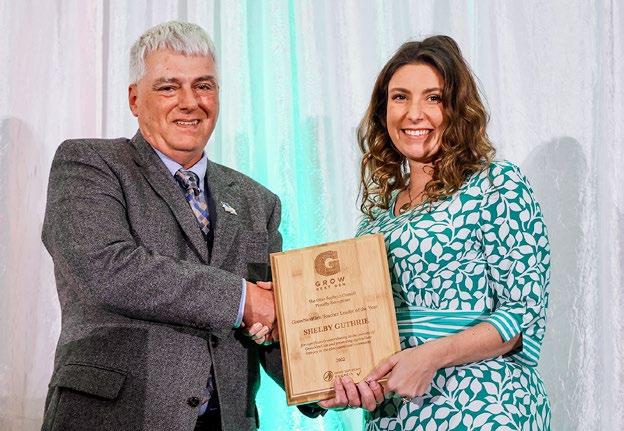
completed the leadership program with GrowNextGen.
Guthrie has been a GNG Teacher Leader for the past several years, presented at workshops and at the Ohio Association of Agricultural Educators, and she’s already reached out about how to engage again this year. She’s shown her support for
Guthrie engages her students in project-based learning. An aquaculture project gave them the opportunity to build an ecosystem where fish byproducts are used to grow plants.
The students even created a commercial for their project. “It’s a career I may want to pursue,” a student said. “It connects with biology, chemistry and math.”
“Agricultural education involves more than just teaching students the basics of seed production or how to judge livestock,” Guthrie said. “It provides the opportunity for people to understand that agriculture is not just farming; it’s a sustainable
way of life. Sustainability is a key component to apply in everyday life and experience rewarding outcomes.”
“Guthrie does a great job sharing about what GrowNextGen has to offer because she uses the resources herself,” Hunt said. “She teaches the lessons in her classroom, has her students attend the virtual field trips, and uses the e-learning courses. Her students have presented the soybean seed necklace activity at community events. She is always willing to try new things and give feedback. We’re so thankful that she’s on our team!”
The Ohio Soybean Council appreciates the commitment Ohio teachers have for sharing the values of agriculture and introducing students to career possibilities in the field. Guthrie’s contribution to the GrowNextGen program and the future of agriculture made her a deserving candidate for the award. Guthrie was presented with the 2022 GrowNextGen Teacher Leader of the Year award at Ohio Soybean’s industry dinner last November. u
Battle for the Belt: Which Crop Should Be Planted First, Soybeans or Corn?
By Laura Lindsey and Osler Ortez
For both soybeans and corn, earlier planting is important to maximize crop yield. Based on previously-funded soybean checkoff research, soybean yield can decrease as much as 0.5 bushel per acre for each day planted after the end of April. Thus, planting May 30 instead of May 1 could mean a 15-bushel per acre loss. Similarly, for corn, yield can decrease up to 1.75 bushels per acre for each day planted after the end of April. Although farmers are keenly aware of the importance of soybean and corn planting date, weather is a severely limiting factor. Since 1995, only about half of the days in May have been suitable for fieldwork in Ohio, and between 1995 and 2022, fieldwork days in May have decreased an average of 0.1 days each year.
to answer three key questions:
• “What should farmers plant firstsoybeans or corn?”
• “Which crop has the smallest yield penalty for delayed planting?”
• “Can you adjust your management practices to mitigate losses due to delayed planting?”
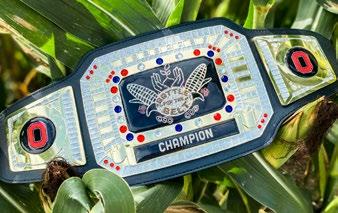
There have been soybean and corn planting date projects across the U.S. and Ohio, but studies that included both corn and soybeans in the same field trial, compared side-by-side, are very limited or non-existent. Each year, farmers need to decide planting priority. The new field research Battle for the Belt led by faculty members at The Ohio State University aims


Starting in March 2023, you can follow the soybean and corn Battle for the Belt project to see which crop should be planted first! The project includes planting corn and soybeans across five different planting timeframes: ultra-early (first two weeks of April), early (second two weeks of April), normal (first two weeks of May), late (last two weeks of May), and very late (first two weeks of June) at three locations in Ohio: Wood County, Wayne County and Clark County. Corn and soybeans will be planted the same days within the same fields for a head-to-head comparison.
The project will have short, weekly video updates from the field to track each crop’s progress as
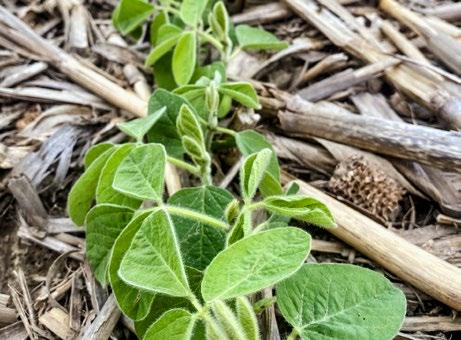
well as updates from research and extension specialists. Planting date is a very important management practice — planting too early or too late can have weed, insect, and disease implications. To stay upto-date on this project and results, make sure you subscribe to Ohio State Extension’s Crop Observation and Recommendation Network (C.O.R.N.) newsletter or the Ohio State Agronomy YouTube channel. You can also follow the AgCrops Team via Twitter using @OSU_Agronomy. Please reach out to Dr. Laura Lindsey (Ohio’s Soybean Specialist) or Dr. Osler Ortez (Ohio’s Corn Specialist) with any questions/ comments that you may have. The research team is excited to begin work on this project and start finding out which crop should be planted first. You are invited to follow along and see which crop should be planted first, the winning crop will be awarded the Battle for the Belt championship wrestling belt. u
Soybean agronomist, Dr. Laura Lindsey, and corn agronomist, Dr. Osler Ortez, prepare for the soybean and corn planting date battle.
Assessing Within-Field Variability in Soybean Emergence Using UAV-Based Remote Sensing Technology
By Sami Khanal, Ph.D., Assistant Professor, The Ohio State University College of Food, Agricultural and Biological Engineering

Detection and diagnosis of soybean emergence problems are necessary to optimize farming practices for achieving high yields and thus profitability. Early diagnosis of these factors enables farmers to minimize potential yield losses by taking timely actions such as replanting.
Currently, the most common approaches to the detection and diagnosis of soybean emergence problems involve the use of crop scouts, which is labor and timeintensive and can be subjective depending on the crop scouts’ experience. With so many acres to scout, detecting areas with low or delayed emergence via manual approaches can be tedious. This results in limited ground-truth observations, which might prevent us from identifying the factors contributing to emergence problems. As such, problem areas could go unnoticed before it is too late to make a replanting decision, which
would then result in low yield and less profit. While some studies have indicated that poor soybean stands can yield well because they branch more, in most cases the low plant population density results in allowing weeds to emerge much faster, creating serious problems such as additional treatment of the entire field with herbicides. Through proper detection of areas within fields with low plant population density, farmers could also target their weed control efforts in those areas. Consequently, there is a need for timely, effective, efficient approaches for detecting and mapping soybean emergence problems, as well as identifying the factors contributing to poor soybean emergence and yield to help soybean growers make better management decisions.
In recent years, using unmanned aerial vehicles (a.k.a. drones) has emerged as a cost-effective option for acquiring timely crop health information over a large geographic area that can be used for detecting
(a) Set-up for drone flights. (b) Drone image of a soybean field. (c) Zoomed-in image of the field. (d) Detection of soybean rows using the image. (e) Identified soybean plant stands, and (f) Number of soybean plants detected in various sections of the field based on the drone image.
and diagnosing any crop health problems. Some significant steps have already been taken at The Ohio State University to investigate if this option can be successfully adopted by the growers. As a part of the project supported by the Ohio Soybean Council, researchers from the AgSensing Lab at Ohio State have developed a computer algorithm that provides farmers with highresolution soybean emergence maps that indicate which section of the field has less emergence than others.
The computer algorithm Ohio State researchers have developed uses very high-resolution visible images collected by a drone at a height of around 30 feet at early soybean growth stages of V2-V3. Computer vision algorithms are then applied to images to separate plants from non-plants, as well as identify every single crop row in the field. The detected soybean crop rows are used to avoid potential confusion between soybean stands and weeds that are present in between the crop rows. Currently, the accuracy of the program is between 80 to 90 percent, with higher accuracy in sections of the fields with reduced crop residues from the previous harvest and lower in sections with high crop residues. Researchers are focusing on improving the accuracy of the algorithm to almost 100 percent by implementing additional computer vision algorithms that can effectively separate soybean stands from crop residues. u

Soybean Seed Protein Content, Oil Content and Yield: It’s Complicated
By Leah McHale, Ph.D., Professor, The Ohio State University
The relationship between seed protein, oil and yield
Since the transition of soybeans from a forage to an oilseed crop in the U.S., breeding efforts have resulted in increased soybean yields in U.S. farming systems. Yet, the complex relationships between seed yield, seed oil content and seed protein content have also resulted in decreased seed protein content and decreased estimated processing value per bushel of soybeans. The processing value of soybeans can be estimated using seed protein and oil contents (concentrations) as inputs and multiplying the predicted meal and oil outputs by available market prices.
Though seed protein and oil contents can potentially influence global market trends, farmers are primarily paid based on yield at the grain elevator. Thus, yield remains the top priority for commercial cultivar breeding programs. The negative relationships between yield and seed protein content, seed protein and oil content, and the positive relationship between seed oil content and yield have led to changes in the soybean seed. As breeders have improved yield, seed protein content has declined, in some cases below 34.5 percent, the minimum protein meal quality threshold. Decreases in seed protein content could potentially impact the standing of U.S. soybeans in the global market.
Figuring out the genes involved
To overcome these challenges, soybean researchers have been working to understand which genes control the seed protein and oil content for more than 30 years. These studies have resulted in the identification of over
600 genetic regions associated with seed protein and oil content. While breeders are harnessing the natural variation occurring in these genetic regions to improve soybean cultivars, there are also research efforts and recent advances toward pinpointing the genes responsible for these traits.
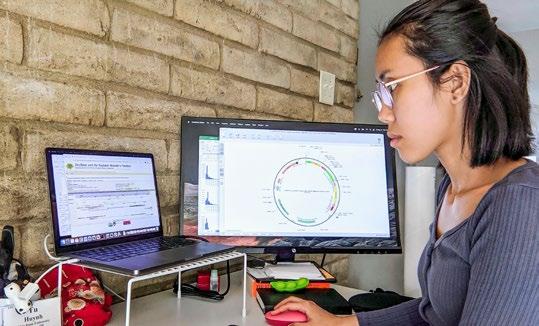
Finding these genes can help soybean breeders and geneticists to design cultivars with high processing value and to dissect the complex relationship between seed protein, oil and yield. The further identification of genes controlling soybean seed protein and oil contents could reveal new breeding and genetic engineering approaches to break the negative relationships between seed protein content and seed yield, and between seed protein and oil content to maximize seed protein content, oil content and yield.
To this end, data from earlier genetic studies has been curated to identify 52 high-confidence genetic regions impacting seed protein and oil contents across multiple environments and cultivars. These genetic regions were triaged for those that were relatively small, containing a limited number of genes. Available
data on these hundreds of genes were compiled; this included comparisons of the DNA sequences of these genes to those from other plant species. Finally, seven target genes, each specific to different genetic regions impacting seed protein and oil contents, were selected for transgenic modification. Transgenic soybean plants with either increased or decreased expression of each of the genes are being grown. The impact of these genes on the soybean’s seed protein and oil content as well as seed yield can then be evaluated. This work will lead to the design of improved quality and yield of soybeans by breeders and genetic engineers. Ultimately, this will keep soybeans profitable for U.S. farmers. u
The initial (T0 generation) transgenic plants for altering the seed expression of genes potentially involved in oil transport (left 2 plants) or involved in synthesizing oil (right 3 plants). Plants are growing in a greenhouse at The University of Nebraska – Lincoln.

Tu Huynh
Your Soy Checkoff Offers Agronomic Support in All Areas
Have you ever found yourself in a pinch, quickly trying to find information on a problem in the field? Your soy checkoff is dedicated to giving you the most up-to-date, unbiased agronomic information to help you grow profits on your farm from the soil up. The checkoff works with experts, from university researchers and extension specialists to leaders at major agrochemical companies, to develop resources you can keep in the truck — or on your phone — and
resources and tools to help farmers adopt management practices that lessen the impacts of resistant pests and preserve current and future crop protection technology. Take Action is an industrywide initiative informed by land-grant university weed scientists, plant pathologists and entomologists and endorsed by major ag chemical companies, ag-focused professional organizations and the soy, corn, cotton, sorghum and wheat commodity groups. Read more at iwilltakeaction.com.

use while you’re in the field. Checkoff investments support translating research into on-farm application with resources and information on pesticide-resistance management, soybean cyst nematode management, crop protection, production research results and more.
Take Action
Take Action: Pesticide-Resistance Management is a farmer-focused education platform dedicated to helping farmers manage herbicide, fungicide and insect resistance. Take Action provides research-backed
The SCN Coalition
The SCN Coalition offers management resources and downloadable tools to combat the evolving threat from soybean cyst nematodes. From scouting and soil testing resources to in-depth presentations and training, the coalition encourages farmers and agronomists to take the test and beat the pest. The SCN Coalition is a diverse group of university researchers, extension specialists and ag industry representatives, supported by a variety of industrywide
organizations, including your soy checkoff. Start your fight against SCN at thescncoalition.com
Crop Protection Network (CPN)
The Crop Protection Network provides publications, tools and training for farmers and ag professionals to inform row crop management decisions, including corn, small grains and soybeans. CPN, with support from your soy checkoff, enhances the visibility and success of agricultural extension while providing important soybean crop protection information. Learn more at cropprotectionnetwork.org
Soybean Research and Information Network (SRIN)
The Soybean Research and Information Network is your source for the checkoff research driving soybean innovation. SRIN provides checkoff research highlights from your state and translates the results into agronomic resources so you can apply the findings on your farm. Visit soybeanresearchinfo.com for more information.
The Ohio State University
The researchers at The Ohio State University have worked for decades to build a research portfolio specifically crafted to meet Ohio soybean farmers’ needs. Your checkoff dollars play a big role in getting that research done. You can find more about how your dollars are used in this important work and what the results of this important research are indicating at soyohio.org. Don’t find yourself in a pinch when you need agronomic information — and fast. Put your soy checkoff investment to work with these resources to help you tackle many of the problems that could arise in your fields. u
Sticking It to Stink Bugs
By Dr. Kelley Tilmon, Ph.D., Professor of Entomology, The Ohio State University
There are several species of stink bugs which can be found in Ohio soybeans. They all damage soybeans in the same way, by using their straw-like piercing mouthparts to punch through the pod wall and feed on the developing seed. They also inject a digestive enzyme to help break down the seed tissue. The combined effect is aborted seeds (if the feeding happens early), or shriveled, shrunken, often discolored seeds (if the feeding happens later). This feeding may
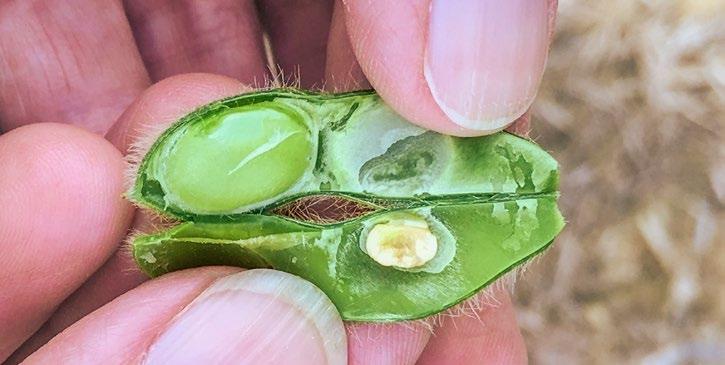
spread plant pathogens to the pods. The combined effect of enough stink bug pressure is yield loss by weight and a reduction in seed quality.
Stink bug feeding is stealthy because it is not apparent to casual inspection, the way that defoliation from leaf-feeding insects is. If enough pods are inspected, you may find pods with flattened areas where a seed failed to develop, or you may open the pod to find shriveled seeds. Because the feeding damage doesn’t jump out at you, many farmers don’t know they had a stink bug problem until the yield monitor starts to dip, especially on field edges where stink bugs are prevalent.
The good news is that stink bugs

are effectively controlled by most of the insecticides labeled for them in soybeans. The key to applying this treatment when it’s needed is scouting to diagnose the problem. August and early September are key times for stink bug scouting, which is usually done with a sweep net. The trouble is that soybean vegetation is dense towards the end of the season and it can be difficult to move through the field for effective sweep net sampling. Thus many soybean fields are under-scouted for stink bug populations.
The Ohio Soybean Council has been funding Ohio State research to find a solution to this problem. We are working to adapt scouting technologies used with stink bugs in orchards, where they damage fruit. Researchers of orchard pests have developed a stink bug monitoring tool which uses a pheromone lure to attract stink bugs to a sticky trap. This trap can be monitored for stink bug buildup and control applied at an appropriate level of pest pressure. Our research is to adapt this tool for use in soybean fields, so that a lure or trap can be mounted on a post at the edge of the field and visually inspected without the need to enter the field and sweep dense vegetation. Though it sounds simple, many questions have to be answered to optimize this stink bug monitoring tool for soybean farmers. For example, how many traps do you
need and how far apart should they be spaced? How consistently does the trap reflect what’s actually in the field? And, most importantly, what does the number of stink bugs that we count in the trap mean in terms of when treatment is warranted? There will always be stink bugs captured on the trap, but only at a certain level will this indicate a stink bug population where the spray will pay for itself.
This work is still in progress, but the preliminary results are promising. We have determined how far apart the traps should be and established that there is a fairly consistent correlation between trap captures and actual field populations. The next step is to translate this to specific management advice.
The Ohio Soybean Council investment in this project has had a multiplier effect. Based on the preliminary results, this research is also being conducted now as a multistate project funded by the North Central Soybean Research Program, investigating the attractand-trap technique in soybeans in seven Midwestern states. Once the kinks are worked out of this method it may change how stink bug scouting is done throughout the Midwest — something that Ohio soybean farmers can be proud of! u
3-D Printing to Improve Insect and Pathogen Scouting
By Dr. Andrew Michel, Ph.D., Associate Chair and Professor of Entomology, The Ohio State University

One of the biggest challenges for soybean farmers is accurately scouting soybean fields for insects and pathogens. These yield-robbers are often small, hide in various places on the plant, or look like non-pests. Sometimes, even our best pest and pathogen monitoring methods have difficulties finding them. Pheromone traps can catch different insect species and it seems like some species of stink bugs “know” when an insect sweep net is coming and drop to the ground to evade capture. All of these problems lead to unnecessary pesticide applications, which cost farmers money and promotes the development of pesticide resistance.
With a recently funded project by the Ohio Soybean Council, The Ohio State University has started to develop and incorporate 3-D printed models that enhance extension programming. We have focused on key issues facing
Ohio soybean producers and created models that will help in determining if a pesticide application is necessary. For example, insect feeding on soybean leaves (i.e., defoliation) is very hard to estimate. Most people tend to overestimate the amount of leaf damage, and this overestimation can lead to insecticide spraying when it’s not needed. Our testing showed that mobile-based apps are more time consuming and less accurate in the field. One of our first models included a set of individual 3-D printed soybean leaves that represent different levels of percent defoliation: 10 percent, 15 percent and 30 percent. These leaves also represent the threshold recommendations at different growth stages of soybeans. These plastic leaves are waterproof and easy to use in the field for a more accurate estimation of defoliation.
We are also using 3-D printing to raise awareness of new invasive
species. The soybean gall midge first appeared in Nebraska in 2018 and is continuing to spread in the Western corn belt. While it is not in Ohio yet, we created soybean gall midge keychains that can help farmers be first responders and detect invasions early. We have also worked with Ohio State Plant Pathology and created a soybean leaf with the common pathogen frog-eye leaf spot. We will be printing a set of leaves with varying levels of frog-eye leaf spot infestation to help growers identify the pathogen and make management decisions. Our future goals include developing models for other pathogens and refining models for other insect pests such as the various species of stink bugs and defoliators. We have already used basic, one-color models of stink bugs to help soybean farmers gain experience in spotting them in fields. Through the support of the Ohio Soybean Council, we will be able to provide these models to soybean farmers at upcoming extension events. Keep in contact with your

local extension educator for events in 2023 where we will be incorporating 3-D printing for extension activities that help soybean farmers and crop consultants gain experience and confidence in scouting. u
3-D printed gall midge key tag.
3-D printed models of defoliation leaves with economic threshold guidelines.
Integrated SCN Management Through Resistance and Seed Protectant
By Horacio Lopez-Nicora, Ph.D., Assistant Professor, The Ohio State University
The soybean cyst nematode (SCN) remains the most economically important pathogen of soybeans because it can significantly reduce yield with no visible symptoms. From 2018 to date, with funding from the soybean checkoff through the Ohio Soybean Council and The SCN Coalition, we received over 1,000 soil samples from 60 counties in Ohio and processed for SCN. More than 65% of these soil samples had SCN. Moreover, the current and most prevalent SCN population in Ohio is HG type 2-, which can reproduce on PI 88788 at levels above 10% and up to 80% of a susceptible soybean. A resistant cultivar will not allow more than 10% SCN reproduction compared to a susceptible.
Resistance remains the best management strategy against SCN. However, as this nematode continues to spread throughout Ohio and SCN continues to adapt, we must integrate different management tactics. To most effectively manage SCN, we can rotate to a nonhost crop (e.g., corn, small grains, etc.), rotate sources of SCN resistance [i.e., use different soybean cultivars with different sources of resistance (Peking, PI 88788, etc.)], and boost SCNresistant soybean health by adding a seed protectant (i.e., seed treatment).
This year, we conducted a field trial at The Ohio State University’s North Central Agricultural Research Station located in Sandusky. The field is infested with an SCN population that can reproduce on PI 88788-derived soybean cultivars (i.e., HG type 2-) and the initial population (at planting) was 13,500 eggs/100 cm3 soil. In Ohio, SCN population levels above 5,000

Mean
eggs/100 cm3 soil are considered “high”. We evaluated the effect of soybean cultivars with two different sources of resistance to SCN: PI 88788 and Peking. Additionally, half of these seeds were treated with ILEVO, a fungicide applied as seed protectant and labeled to manage sudden death syndrome (SDS) and SCN. We collected soil samples at planting and at harvest to obtain the SCN initial (Pi) and final (Pf) population, respectively. We then calculated the reproduction factor (RF = Pf/Pi), a ratio between the SCN final and initial population.
The reproduction factor is very informative and simple to obtain. If RF = 1, then the SCN population remained constant and unaltered (i.e., did not increase or decrease); if RF > 1, then SCN was able to reproduce on that specific soybean cultivar and its final population increased; finally, an RF < 1 will indicate a reduction in the SCN population at the end of the season. In other words, an RF < 1 means that the nematode was not able to reproduce and that the management strategies used were effective.
On average, soybean cultivars with Peking-derived resistance decreased SCN population at the end of the
season (RF < 1), whereas soybean with PI 88788 resistance had on average RF > 1. In this study, there was no statistically significant effect of seed treatment on SCN RF. However, when we compare the effect of ILEVO within each soybean cultivar, we observed a significant yield increase due to the seed treatment (see chart). Peking-derived resistant soybeans treated with ILEVO yield on average 3.5 Bu/A more than untreated seeds. For soybean cultivars with PI 88788 resistance, ILEVO treated seeds yield on average 2.6 Bu/A more than the untreated seeds. One additional result from this study, was evaluating the relationship between yield and SCN population. As SCN population increases, yield decreases for the soybean cultivars with PI 88788 resistance, however, Peking-derived resistant soybean yield remains unaffected.
In summary, the use of effective SCN resistance remains the best management strategy to reduce SCN populations in infested fields. We must understand and know the SCN population type of a field to select the corresponding SCN-resistant soybean cultivar. Therefore, soybean cultivars labeled ‘resistant to SCN’ are not enough, we need to know the source of SCN resistance (PI 88788, Peking, etc.) present in the soybean cultivars and what SCN type (HG type 0, 2-, etc.) we are trying to manage. Complementing SCN resistance with seed protectants will increase soybean health and ultimately increase production and profitability. Next year we will repeat this trial, but we also want to evaluate other SCN sources of resistance and seed protectant products. u
soybean yield (bushel per acre) for cultivars treated (or not) with ILEVO and Peking or PI 88788 source of resistance to soybean cyst nematode (SCN).

IOM Grain has been your source for high-quality, high-yield, food-grade, non-GMO soybeans for over 20 years. Now we’re excited to expand our offering to include non-GMO VIRTUE Seeds and GMO DONMARIO Seeds—both derived from GDM genetics, which make up 40% of the world’s planted soybean acres.
VIRTUE and DONMARIO Seeds are exclusive soybean varieties not offered in any other brand or bag. Their powerful genetics drive higher yields that are protected by the most advanced trait options. IOM Grain works with only the best brands committed to seed quality standards that surpass industry standards.
IOM Grain is your source for superior-quality, high-yielding soybeans that earn the highest premiums on non-GMO and GMO soybeans. Contact IOM Grain today.
2022 Weed Report
By Alyssa Essman, Visiting Assistant Professor, The Ohio State University College of Food, Agricultural, and Environmental Sciences — Horticulture and Crop Science
Weeds are one of the most economically important pests in soybean production. The Weed Science program at The Ohio State University is committed to conducting research and outreach to address the most pressing weed related concerns.
At present, the top research objectives are to:
1) Evaluate the efficacy of different herbicide programs in agronomic crop production,
2) Monitor the frequency and distribution of problematic weed species in Ohio,
3) Screen for potential herbicide resistance in waterhemp and Palmer amaranth populations,
4) Determine the role of cover crops for weed suppression and optimize their use with various herbicide inputs.
As a result of funding provided by the Ohio Soybean Council, we have been able to conduct research with grower interests in mind and provide data-driven recommendations. One of the most valuable outcomes of this funding has been an annual driving survey evaluating late-season weed escapes in soybean fields across the state. In 2022, 57 percent of fields were clean, or free of the ten weeds that were evaluated. Overall, Ohio soybean growers are implementing effective weed management programs. The most encountered weed species in order of frequency (or percent of fields encountered with the weed present) were giant ragweed (12 percent), waterhemp (11 percent), marestail (10 percent), grass/foxtail
spp. (9 percent) and volunteer corn (8 percent).
One of the most concerning trends in recent years is the rise in waterhemp populations. In 2020, pigweed species — redroot pigweed, waterhemp, and Palmer amaranth — were found in a combined 8 percent of surveyed fields. During the 2021 survey, waterhemp alone was observed in 77 percent of the surveyed counties and in seven percent of the 3,600 fields evaluated. These numbers increased during the 2022 survey, where waterhemp was found in 94 percent of surveyed counties and 11 percent of the 4,200 fields evaluated.
At present, waterhemp presents one of the greatest threats to soybean production in Ohio. One of the more recent additions to the Ohio noxious weed law, waterhemp possesses a number of biological characteristics that make it especially problematic, including: immense seed production, fast growth rate, prolonged emergence window and
high genetic diversity. Waterhemp can develop herbicide resistance at an accelerated rate, due in part to high genetic diversity. It has developed resistance to seven herbicide sites of action in other states. As we look forward to the 2023 growing season, the identification and management of troublesome weeds such as waterhemp should be a priority.
The weed science program at Ohio State is currently in a transitionary period with the recent retirement of Dr. Mark Loux. In his time at OSU, he created a strong research and extension program in support of Ohio growers. Thanks to his legacy and years of service, the mission continues, and we now look to the future. The Department of Horticulture and Crop Science at Ohio State is currently searching for two new additions. The weed science program at Ohio State looks forward to providing continued service to growers across the state, with sincere gratitude for the support provided by the Ohio Soybean Council. u
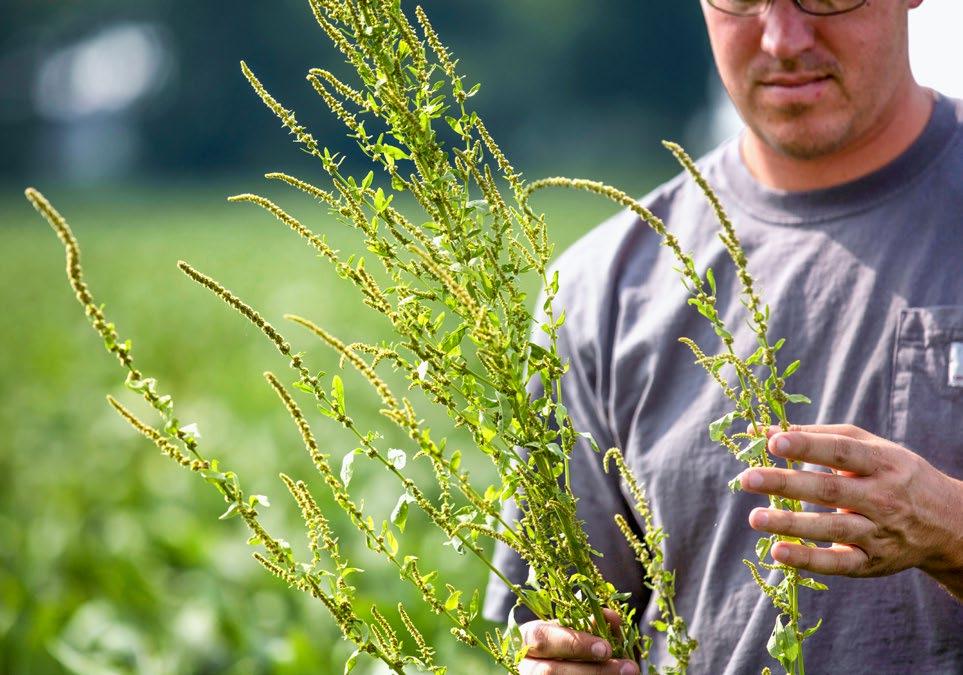
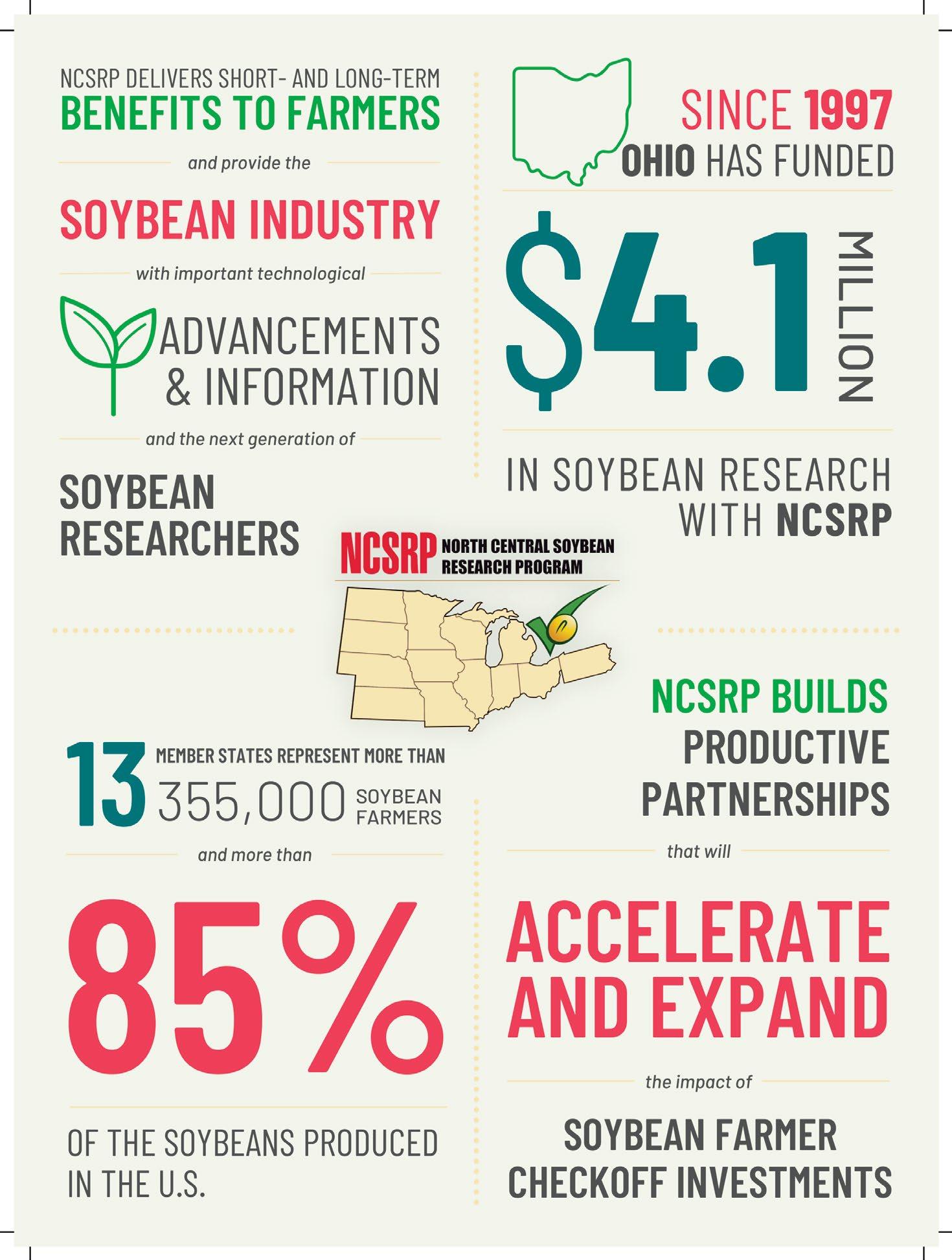

Behind the Beans: Investing in Cutting Edge Research
By Tom Fontana, Director of Research and Education, Ohio Soybean Council
For almost 18 years, it has been my honor to be the project manager for the checkofffunded plant research with the Ohio Soybean Council (OSC). During my time, the number of plant research projects that have been funded on an annual basis has grown considerably. In any given year the total of the various plant research projects approved by the OSC volunteer farmer board will range from $750,000 to $1,250,000, depending on the budget available and the number of worthy project proposals submitted.
Most of the projects approved by the OSC board are with researchers at The Ohio State University, as it is the major land grant institution in Ohio. The university has an excellent team of basic and applied researchers working on soybean-related projects that are important to Ohio soybean farmers. These researchers represent a variety of disciplines important to the long-term prosperity of the soybean industry including
agronomy, plant pathology, plant breeding, entomology, soil health, water quality, precision technology, data management and extension education. OSC, in conjunction with Ohio State, worked to establish The Center for Soybean Research at the university to encourage collaboration of researchers across these disciplines to work together on important issues facing soybean growers in a costeffective and efficient manner.
On a more regional and national scale, OSC sponsors research in several ways. We are a member of the North Central Soybean Research Program (NCSRP) along with twelve other states. NCSRP is recognized as a leader in multi-state collaborative research and outreach efforts to support soybean farmers and drive the industry forward. NCSRPfunded programs and projects are not redundant with current state(Qualified State Soybean Boards) or nationally- (United Soybean Board) funded programs but complement and extend state or nationally
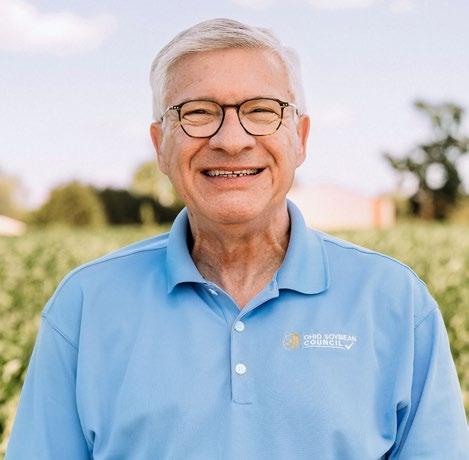
funded projects when addressing the common interests and needs of North Central region soybean growers. An example of national cooperation is the Science for Success group which consists of state soybean extension specialists. This group’s mission is to better coordinate and collaborate among research partners to execute nationally replicated research trials across seventeen states and help deliver best management practices from this research to growers. u
Some specific areas of research funded by Ohio soybean farmers over the years include the following:
• Research on soybean diseases such as Phytophthora, Sudden Death Syndrome, frogeye leaf spot, charcoal rot, white mold and others to identify genes for resistance and best field management practices
• In-field trials to determine best practices on seeding rate, fungicide and fertilizer use, biological seed treatments, row spacing, cover crops, early planting and preserving water quality
• Monitoring for insect problems in Ohio and providing best practices and educational materials for their identification and control
• Development of new varieties of soybeans for specialty
premium markets and identifying soybean resistance genes to control disease and pests
• Developing precision agriculture systems to help soybean farmers to identify and control diseases, weed pressure, insect infestation and defoliation in their fields
• Developing new economical soil tests that provide more information to farmers and researching the effect that bacteria, fungi, microbes and nematodes have on soil health
• Monitoring Soybean Cyst Nematode (SCN) populations in Ohio, providing free SCN testing, researching best practices for control of SCN and educating farmers on these methods
Tom Fontana

“Through the Soybean Council and as an Ohio soybean farmer, I am proud that we’re helping feed the world.” -CINDY LAYMAN, SOYBEAN GROWER KENTON, OH
